Viola rostrata Pursh
Common names:
Long-spurred Violet
Synonyms:
Viola rostrata Pursh, Fl. Amer. sept. 1: 174. 1813; Lophion rostratum (Pursh) Nieuwl. & Kaczm., Amer. Midl. Naturalist 3: 216. 1914. TYPE: [USA, Pennsylvania], Easton, [no date], [F. Pursh s.n.] (NEOTYPE (designated by Ballard et al. 2020. Journal of the Botanical Research Institute of Texas 14(2): 226): K000327818!, internet image!).
Viola rostrata Pursh f. trirostrata Grover, Ohio J. Sci. 39: 147. 1939
Viola rostrata Pursh var. elongata Farw., Rep. (Annual) Michigan Acad. Sci. 19: 249. 1917
Description:
Caulescent perennials from somewhat slender rhizome, stems ascending in flower but often reclining in fruit, commonly ≥ 2, ≤ 20 cm tall; stems, foliage and peduncles dark green, glabrous or upper surface of leaf blades with sparse short appressed hairs; leaves cauline and basal, cauline distributed along stem; stipules free, weakly lacerate; leaves ascending to spreading, leaf blades undivided, largest ≤ 43 × 31 mm, narrowly to broadly ovate, base deeply cordate, margins remotely serrate-crenate, eciliate, apex acute to acuminate; chasmogamous flower ≤ 23 mm; calyx glabrous, eciliate; lowest sepals linear-lanceolate, sharply acute; auricles short to somewhat developed and entire, not elongating in fruit; corolla pale violet with pronounced purple-black eyespot, throat white; spur very long, slender, 10&ndash20 mm, pale violet; all petals glabrous; cleistogamous flowers produced after chasmogamous, capsule 4.5–8 mm, green drying tan, unspotted or with fine red spots or lines, glabrous; seeds 1.8–2.0 × 1.1–1.2 mm, medium brown, unspotted; 2n=20.
Similar species:
In chasmogamous flower this caulescent species is unmistakable in its very elongate spur, glabrous petals, and pale violet corolla with dense coalescing nectarguide-lines forming a conspicuously contrasting dark eyespot around the throat. In cleistogamous fruit it is most often confused with species commonly growing with it, Viola canadensis, Viola eriocarpa, Viola labradorica, and Viola striata. It differs from Viola canadensis in its wholly herbaceous weakly lacerate stipules, and leaf blades with remotely serrate-crenate margins; from Viola eriocarpa in its glabrous foliage or leaf blades with sparse small hairs, and wholly herbaceous weakly lacerate stipules; and from Viola labradorica and striata in its proportionally longer leaf blades with a more prolonged abruptly acute to acuminate apex and remote serrate-crenate margins, and proportionally longer stipules.
Ecology:
Well-drained sandy soils in dry-mesic forests, acidic cove forests, and on drier slopes and terraces in mesic and wet-mesic forests, often under Tsuga canadensis to the south.
Distribution:
Widespread in e. North America, QC to e. WI, south to NJ, GA, AL, e. KY, and IL.
Rarity:
State listed in MD, NH, NJ, and WI.
Phenology:
Chasmogamous flower April–June (July), chasmogamous fruit April–June, cleistogamous fruit July–August.
Affinities:
This species belongs to the Rostrate Violet lineage, sect. Viola, subsect. Rostratae (Kupffer.) W.Becker.
Hybrids:
Hybridizes with V. labradorica (Brainerd 1924, Henry 1953a, Scoggan 1978, Ballard 1990a, 1992, 1995, Haines et al. 2011) and striata (Brainerd 1924, Henry 1953a, Boivin 1966, Cooperrider 1986, Ballard 1990a, 1992, 1995). I have observed the hybrids and have found the features of chasmogamous flowers and foliage to be more or less precisely intermediate. Hybrids fail to reproduce by chasmogamous flowers, and cleistogamous capsules commonly abort before maturity.
Comments:
Pursh noted in his protologue that this species was found “On shady rocks: near Eastown [= Easton], Pensylvania.” According to Stafleu and Cowan (1983), Pursh’s herbarium was dispersed to several herbaria, including BM, K, OXF, and PH. Pursh cited no types and did not mention a herbarium, but he stated a single area, suggestive of one collection. One sheet at K matches the protologue, with the handwritten statement “Herb. Pursh propr.” at the bottom, but lacks a date. Harvey Ballard incorrectly annotated this sheet as holotype in 1995. Because it is not certain that the sheet was actually used by Pursh in formulating the description, Ballard et al. (2020) conservatively designated K000327818 as a neotype.
Brainerd (1921b), Brainerd Baird (1942), Fernald (1950), Henry (1953a), Alexander (1963), Russell (1965), Scoggan (1978), Strausbaugh and Core (1978), Swink and Wilhelm (1979), Gleason and Cronquist (1991), Ballard (1995, 2000), McKinney and Russell (2002), Haines et al. (2011), Voss and Reznicek (2012), Weakley et al. (2012), and Little and McKinney 2015) have all recognized this distinctive taxon at species rank. The species is unmistakable in chasmogamous flower, with its very long spur and pale violet corolla with striking dark purple eyespot, and beardless lateral petals. Hybrids with other Rostratae species are immediately obvious in chasmogamous flower, inheriting the longer spur and dark eyespot from the present species but exhibiting the lateral petal beards from other species.
Literature Cited:
Alexander, E. J. 1963. Violaceae. In Gleason, H. A., The new Britton and Brown illustrated flora of the northeastern United States and adjacent Canada. Hafner Publishing Co., Inc., New York, NY. 552-567.
Ballard Jr., H. E. 1990a. Hybrids among three caulescent violets, with special reference to Michigan. Michigan Botanist 29: 43-54.
Ballard Jr., H. E. 1992. Systematics of Viola section Viola in North America north of Mexico. M.S. thesis. Central Michigan University, Mount Pleasant, MI.
Ballard Jr., H. E. 1995 ["1994"]. Violets of Michigan. Michigan Botanist 33: 131-199.
Ballard Jr., H. E. 2000. Violaceae. In Rhoads, A. (ed.). Flora of Pennsylvania. University of Pennsylvania Press, Philadelphia, PA. 700-710.
Ballard Jr., H. E., R. N. Burwell, and S. L. Lockhart. 2020. Violaceae: Typifications and clarifications of names. In Weakley, A. S., D. B. Poindexter, H. C. Medford, B. A. Sorrie, C. A. McCormick, E. L. Bridges, S. L. Orzell, K. A. Bradley, H. E. Ballard, Jr., R. N. Burwell, S. L. Lockhart, and A. R. Franck. Studies in the vascular flora of the southeastern United States. VI. Journal of the Botanical Research Institute of Texas 14(2): 217-229.
Boivin, J. R. B. 1966. Enumération des plantes du Canada. Le Naturaliste Canadien 93(5): 583-646.
Brainerd, E. 1921b. Violets of North America. Vermont Agricultural Experiment Station Bulletin 224: 1-172.
Brainerd, E. 1924. The natural violet hybrids of North America. Vermont Agricultural Experiment Station Bulletin 239.
Brainerd Baird, V. 1942. Wild violets of North America. University of California Press, Berkeley, CA.
Cooperrider, T. S. 1986. Viola ×brauniae (Viola rostrata × V. striata). Michigan Botanist 25: 107-109.
Fernald, M. L. 1950. Violaceae. In Gray’s Manual of Botany, 8th ed. American Book Company, New York, NY. 1022-1042.
Gleason, H. A., and A. Cronquist. 1991. Violaceae. In Manual of vascular plants of northeastern United States and adjacent Canada, 2nd ed. New York Botanical Garden, Bronx, NY. 157-163.
Haines, A., E. Farnsworth, and G. Morrison. 2011. Violaceae. In Flora Novae Angliae. Yale University Press, New Haven, CT. 873-886.
Henry, L. K. 1953a. The Violaceae in western Pennsylvania. Castanea 18(2): 37-59.
House, H. D. 1924. Annotated list of the ferns and flowering plants of New York state. Family 83 Violaceae. New York State Museum Bulletin 254: 499-512.
Little, R. J., and L. E. McKinney. 2015. Violaceae. In Flora of North America: Cucurbitaceae to Droseraceae, 106. Oxford University Press, New York, NY.
Malte, M. O. and J. Macoun. 1915. Hybridization in the genus Viola. Ottawa Naturalist 28(11): 145-150, 161-168.
McKinney, L. E., and N. H. Russell. 2002. Violaceae of the southeastern United States. Castanea 67: 369-379.
Russell, N. H. 1965. Violets (Viola) of the central and eastern United States: An introductory survey. Sida 2: 1-113.
Scoggan, H. J. 1978. Violaceae. In Flora of Canada, Part 3–Dicotyledoneae (Saururaceae to Violaceae). National Museums of Canada. Ottawa, Canada. 1103-1115.
Stafleu, F. A., & R. S. Cowan. 1983. Taxonomic literature: a selective guide to botanical publications and collec-tions with dates, commentaries and types, Second edition, Volume 4: P-Sak. Bohn, Scheltema & Holkema, Utrecht, The Netherlands. [https://www.sil.si.edu/DigitalCollections/tl-2/]
Strausbaugh, P. D., and E. L. Core. 1978. Violaceae. In Flora of West Virginia, 2nd ed. Seneca Books, Inc., Morgantown, WV. 644-658.
Swink, F., and G. Wilhelm. 1979. Violaceae. In Plants of the Chicago region, 2nd ed. revised and expanded. Morton Arboretum, Lisle, IL. 384, 801-810.
Voss, E. G., and A. A. Reznicek. 2012. Violaceae. In Field manual of Michigan flora. The University of Michigan Press, Ann Arbor, MI. 913-922.
Weakley, A. S., J. C. Ludwig, and J. F. Townsend. 2012. Violaceae. In Flora of Virginia. BRIT Press, Fort Worth, TX. 963-975.
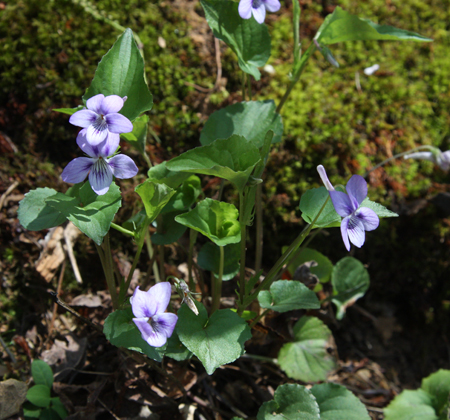
Chasmogamous flowering habit by Bruce Sorrie
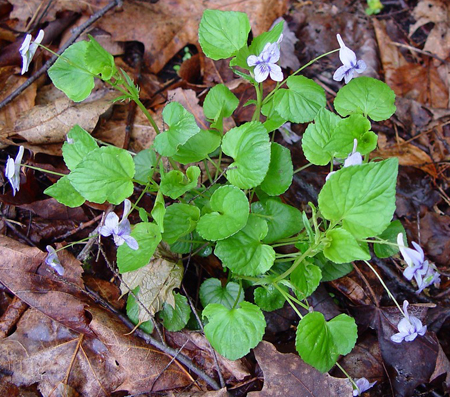
Chasmogamous flowering habit by Arthur Haines, "Go Botany" website, Native Plant Trust
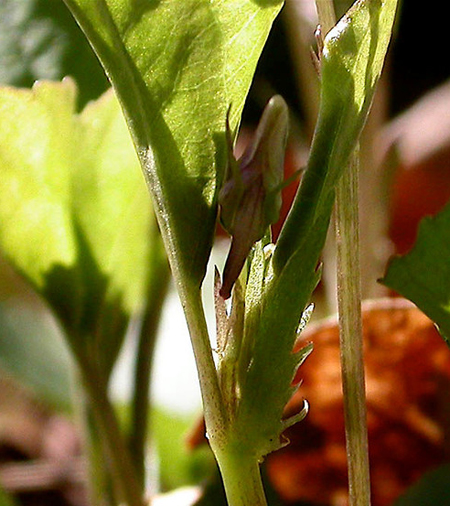
Stipules by P. Pelser, "Go Botany" website, Native Plant Trust

Chasmogamous flower front view by Andrew Gibson, "Buckeye Botanist" website

Chasmogamous flower profile view by Arthur Haines, "Go Botany" website, Native Plant Trust
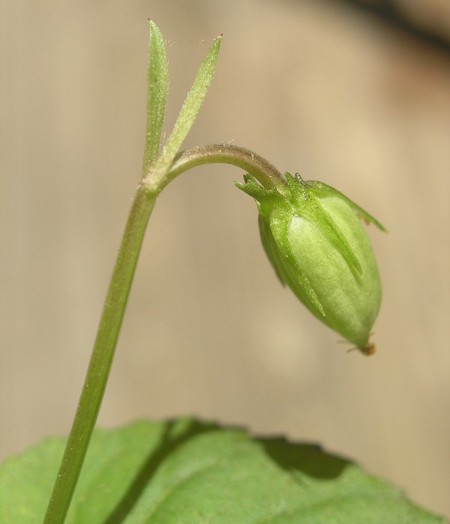
Cleistogamous fruit by Bruce Patterson, "Go Botany" website, Native Plant Trust
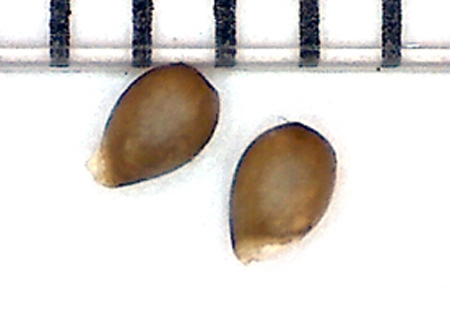
Seeds from herbarium specimen: OH, Hocking Co., Neotoma Ecology Lab, 7 Sep 1970, [no collector] (OS394000)
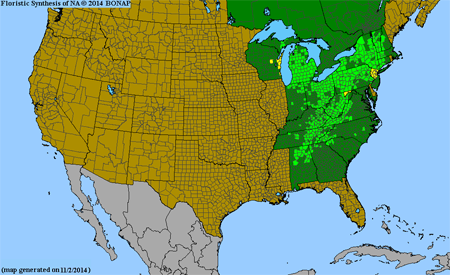
Map by the Biota of North America Program